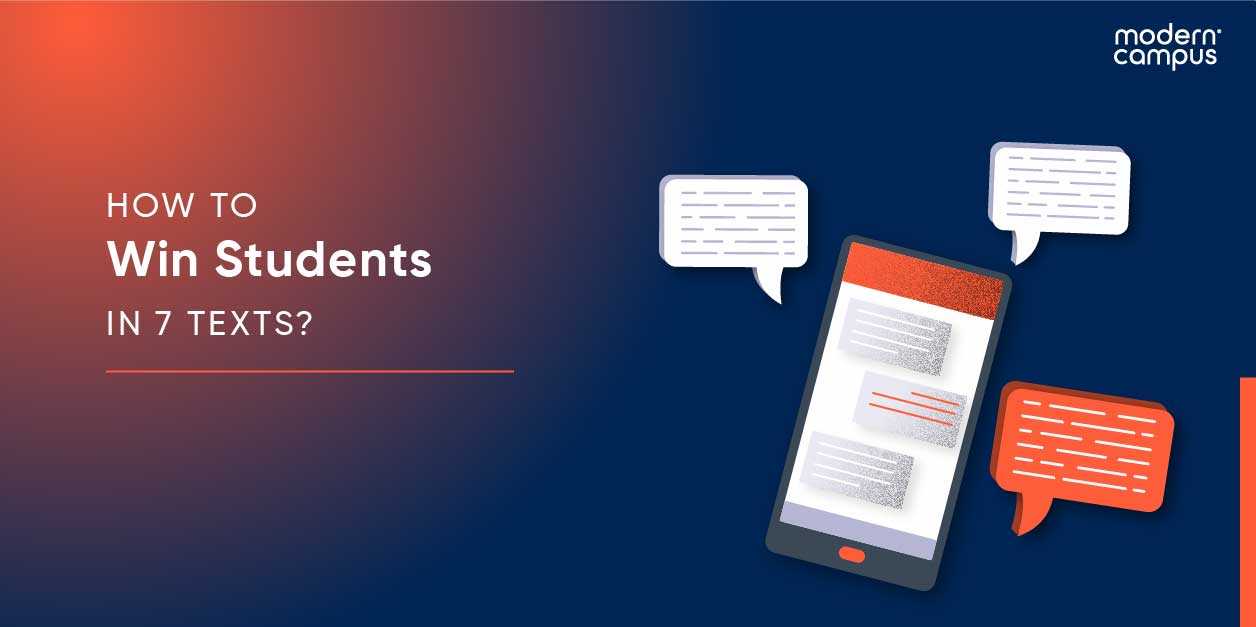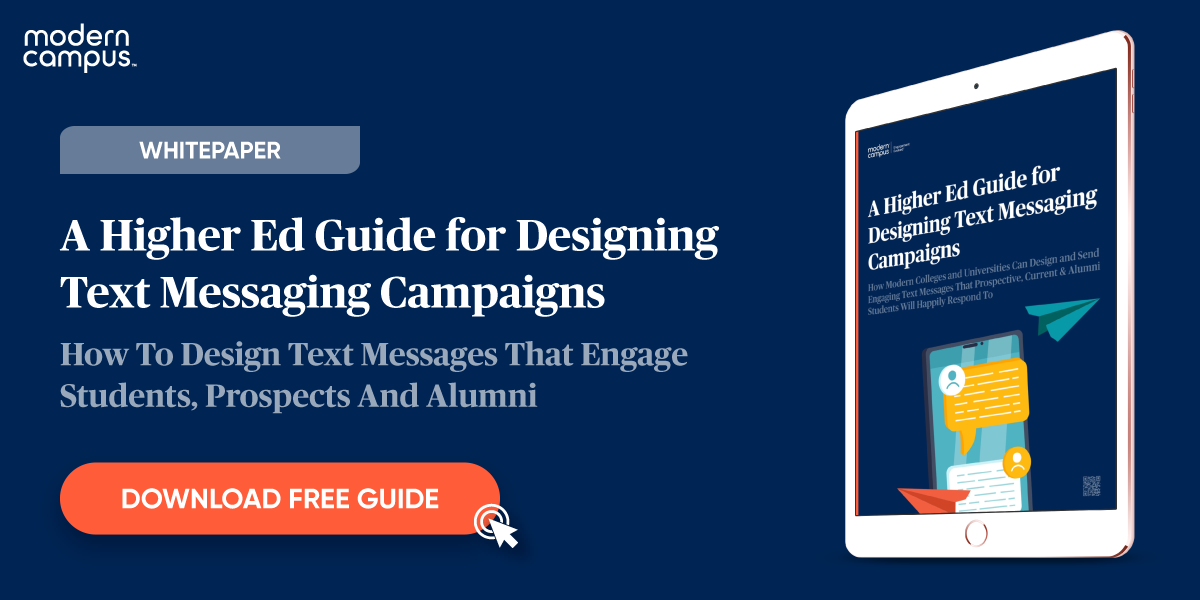How to Win a Student in 7 Texts: Quick Ways to Engage Learners
Email has an average open rate of just 20 percent. Text messages clock an astounding 98 percent.
But reading a message isn’t the same thing as finding value in it—especially among today’s text-savvy higher education students, who are likely to leave poorly constructed messages on read. Worse yet, a bad text message might cause your students to opt out of texts altogether and harm the engaging relationships you’re trying to build.
We don’t want you to get caught in that trap. Fortunately, there are many smart, tested strategies to send texts that are proven to attract students’ attention and keep them engaged.
Want to decrease the number of students who opt out of text messages and start better engaging students with them? Check out these seven winning strategies for higher ed institutions.
1. Introduce yourself
Today’s learners, especially Generation Z, are skeptical of outbound communication. They’re quick to think texts are unsolicited spam. A message that says “Apply to our college today!” or “We’re waiting for your FAFSA,” without revealing who is making these requests, will likely cause most students to ignore or delete the text.
Introducing yourself showcases transparency. You’re not hiding what office or department is behind the message. Better yet, if you share your name (rather than just your job title), you’ll add some personality. Students may even be able to find you listed on your college or university’s website, which lends credibility.
Be sure to include the following elements in your introductory text:
- Who You Are: Say your name, office and institution.
- Why You’re Texting: Let students or prospects know that you’ll be sending relevant, timely messages to help them meet a certain challenge or navigate a certain aspect of student life.
- How To Opt Out: The FCC requires you to tell students how they can opt out of receiving your messages.
Examples:
- ❌ Losing message: Discover financial aid info for Signal Vine College at [link].
- ✅ Winning message: Hi Daniela, this is Kim, your advisor at SVC. 👋 I’ll be texting financial aid info to you this semester. Don’t want texts? Text back “stop.”
2. Keep it shorter than email
It may be tempting to copy-paste your entire email into a text and hit “send” as-is. After all, all four paragraphs are super important!
But think of the last time you received a multi-paragraph text message without groaning. Students don’t want that either.
Your text messages should be precise, ideally no more than 300 characters. You can use links to encourage students to assess additional information directly through the text thread. PDFs and image files can also supply added resources without overwhelming students.
Examples:
- ❌ Losing message: [four paragraphs, including eight links and five bullet points]
- ✅ Winning message: Hi Andres, have you heard about our First-Year Experience Program? It’s a great way to keep the fun of orientation going all semester long. Learn more & register by next Monday here 🔗: [link]
3. Personalize it
Have you ever received a text imploring you to vote for an election in a state you no longer reside in? How about a reminder to renew the insurance for a car you don’t have? It’s pretty annoying, right?
Students almost certainly feel the same way. One wrong message — inviting them to register for courses on a date when they don’t yet have enough course credits to do so, attend an alumni event five states away, or complete a form they filled out months ago — and they’ll likely disengage.
Similarly, generic announcements may also frustrate students. Consider messages like “Most students can apply for housing now” or “Fill out your FAFSA if you haven’t already.” They require students to do the extra work of looking updates or checking to see if they’ve completed a task.
You can help students avoid that work — and increase your engagement rate with texts — through personalization. The secret is segmenting your audiences through SIS or CRM data and targeting communications based on student attributes, Modern Campus Signal Vine makes it easy to send students personalized, relevant text messages.
Examples:
- ❌ Losing message: Course registration opens soon for most students.
- ✅ Winning message: Elliot, course registration for second-year business majors opens in 4 days—Tuesday, 5/21, at 9 am. Here’s the link to register [link].
4. Include a Call-to-Action—and one only
Your texts shouldn't rival the length of a CVS receipt.
We get it: you need students to complete a series of tasks, all equally important. But sending them multiple tasks at once is overwhelming. It’ll feel like homework—and you know your students already have plenty of that.
Instead, nudge students to complete a single goal, such as filling out a form, reading a PDF, or RSVPing for an event. Then, once you’ve confirmed that they’ve completed one call-to-action, you can move on to the next.
Examples:
- ❌ Losing message: Are you interested in Alternative Spring Break, Mikeala? You can read all about it here: [link] and submit your application here: [link]. We also require two faculty or staff recommendations. I’ve attached a PDF about that. And don’t forget to schedule a meeting with the trip’s director here: [link].
- ✅ Winning message: Hi Mikeala, I’m excited to see that you started your application for Alternative Spring Break! ☀️ Do you have any questions for completing it? The deadline is next Tuesday, February 10.
5. Message students on the right days & times
Even the most personalized, expertly written text messages will fail if they're sent at a bad time.
Send a message too soon before an event starts or a task is due, and students may not have enough time to prepare. Send it too early, and students might put off your ask and, ultimately, forget about it. Three to five days is generally a good sweet spot, but tracking response rates through Signal Vine’s advanced analytics can help you build a strategy that's ideal for your students by demographic.
You should also schedule your messages around students’ daily obligations. Texting prospective students works best before or after high school (usually before 8 a.m. or 4 p.m.). Your current, full-time students will respond fastest after 10 a.m., especially around lunch. Adult learners will be more likely to respond outside of work hours, before 9 a.m. and after 5 p.m.
No matter when you text your students, be sure to include details about the time of the event or deadline you’re promoting.
Examples:
- ❌ Losing message: There are some alumni events near you this summer.
- ✅ Winning message: Hi Sofia, heads-up that SV alumni are meeting at Central Creek Park for a family BBQ next Saturday, June 29, noon—3 pm. 🍔🌭 RSVP by June 26 w/ the Chicago chapter here: [link].
6. Use limited emojis, abbreviations & acronyms
A majority—59%—of young adults believe brands are “trying too hard” with emojis. In other words, littering your texts with emojis in every sentence will seem insincere.
But that doesn't mean you need to go completely emoji-free.
Researchers have found that our brains process emojis not as text but as emotional communication. A smiley face emoji, for example, has a similarly positive effect on the recipient as a real human smile. Likewise, 78% of respondents to another survey said that using emojis makes the sender more likable.
So, including emojis in your text may help convey your personality and tell each student how much the sender—and by extension, the institution—cares about their success.
Similarly, abbreviations and acronyms can help you convey a shared sense of culture and build an easy rapport with students while aligning with institutional branding.
But taking your abbreviation game too far might confuse students and lead them to disengage. First-generation, international, and older learners may especially be unfamiliar with certain abbreviations.
When in doubt, it’s best to err on the side of caution; use full names and complete expressions to boost accessibility.
Examples:
- ❌ Losing message: Hi Ryan 👋 ur uni orientation is tmrw. 📅 Check-in’s 9:30 ⏰ in the morn 🌤️@ the Q. Can’t make it❓LMK ASAP to resched. 📝
- ✅ Winning message: Hi Ryan 👋, don’t forget: your SVC orientation is tomorrow. Check-in’s @ 9:30 AM on the main quad, here ➡ [attached map]. Can’t make it? Please tell me ASAP & I’ll help you reschedule.
7. Nudge, don’t nag
No one likes being nagged. Imagine receiving several text messages that bluntly remind you to complete the same task over and over again. That strategy is not appealing to students, and it’s not how the University of Texas at Austin engaged 98% of targeted students through texting.
Instead of nagging, savvy texters embrace nudging.
As demonstrated in our free guide, nudging involves sending students gentle, personalized reminders that guide them through multiple steps to achieve an ultimate goal—such as completing enrollment, applying for work-study, or registering for a Continuing Education course.
Ask questions within your nudges to determine how close students are to completing tasks. Their “yes,” “no,” or “please help” responses will help guide your next nudge.
- ❌ Losing message: Register for Continuing Education courses now.
- ✅ Winning message: Alice, are you still interested in our Introduction to Interior Decorating course?
Monday’s the deadline to register. ⌛ Learn more & register here [link].
Ready to design texts that will win students over? Download our free guide here or below.
You'll find advice on scheduling your texts, designing a texting cadence to compel students to take action, and example messages for:
- Admissions officers
- Enrollment management
- Alumni engagement
- College access organizations
- Continuing Education leaders
- Financial aid officers
- Student affairs professionals
- ...and more!
Last updated: June 30, 2023





